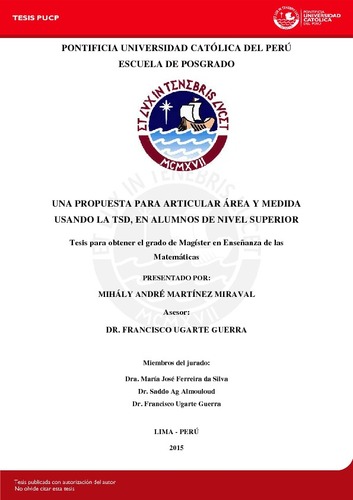| dc.contributor.advisor | Ugarte Guerra, Francisco Javier | |
| dc.contributor.author | Martínez Miraval, Mihály André | es_ES |
| dc.date.accessioned | 2015-07-03T16:58:55Z | es_ES |
| dc.date.available | 2015-07-03T16:58:55Z | es_ES |
| dc.date.created | 2015 | es_ES |
| dc.date.issued | 2015-07-03 | es_ES |
| dc.identifier.uri | http://hdl.handle.net/20.500.12404/6113 | |
| dc.description.abstract | Esta tesis tiene como objetivo analizar el aprendizaje de los estudiantes de primer ciclo
de la carrera de Administración de una universidad de Lima, al trabajar una secuencia
didáctica, mediada por el GeoGebra, que los lleve a modificar y a manipular un
procedimiento flexible con rectángulos, que les permita adquirir la noción de que
pueden aproximarse tanto como quieran a la medida de un área, limitada bajo ciertas
condiciones, y expresar dicha aproximación como la adición de las medidas de las áreas
de cada uno de los rectángulos.
Debido a que los estudiantes conocen fórmulas de geometría y procedimientos de
cálculo para obtener la medida de áreas poligonales, pero desconocen cómo determinar
la medida de un área no poligonal o qué procedimiento emplear para aproximarse a
dicha medida, nos planteamos responder a partir de nuestra investigación la siguiente
interrogante: ¿Una secuencia didáctica, mediada por el GeoGebra, permitirá articular la
concepción que tiene los estudiantes acerca de la medida del área, como un número
asociado al área obtenido mediante fórmulas de geometría, y un procedimiento flexible
que permita aproximar ese número tanto como se quiera y expresar dicha aproximación
como una adición de términos?
Para esta investigación hemos elegido como referencial teórico algunos aspectos de la
Teoría de las Situaciones Didácticas de Brousseau (1986) tanto para el diseño como el
análisis suscitado por la situación didáctica diseñada para esta investigación y que está
centrada en el objeto matemático área y medida. Asimismo, hemos elegido como
referencial metodológico aspectos de la Ingeniería Didáctica de Artigue (1995) donde
analizaremos las fases que conforman su proceso experimental.
Para analizar los resultados obtenidos de la secuencia didáctica, confrontamos el análisis
a priori con el análisis posteriori para observar si los resultados fueron o no previstos
por el investigador. Esta forma de realizar el análisis nos permitió concluir que el
estudiante presenta dificultades para adaptar a su aprendizaje la manera de expresar la
suma de las medidas de las áreas de los rectángulos de aproximación como una adición
de términos. | es_ES |
| dc.description.abstract | This thesis aims to analyse the students learning process in the first term of their
Business Administration studies in a university from Lima, when working a didactic
sequence, regulated by GeoGebra, that leads them to modify and manipulate a flexible
procedure with rectangles that allows them to acquire the conception that they can
approximate, as much as they require, the measure of an area, limited under certain
conditions, and express such approximation as the addition of the measures of each one
of the rectangles areas.
Considering that students know geometry formulas and calculus procedures to obtain
the measure of polygonal areas, but they don’t know how to determine the measure of a
non-polygonal area or what procedure to use to approximate this measure, we plan to
answer, from our research, the following question: Will a didactic sequence, regulated
by GeoGebra, allow the articulation of the conception that students have regarding the
measurement of an area as a number associated to it calculated through geometry
formulas and a flexible procedure that allows to approximate that number as much as it
is required, and to express that approximation as an addition of terms?
For this research, we have selected as theoretical framework some aspects from the
Theory of Didactical Situations from Brousseau (1986), so much for the design as for
the analysis raised by the didactic situation designed for our research, and which is
focused on the mathematical object of area and measurement. Furthermore, we have
chosen as methodological framework aspects from the Didactic Engineering from
Artigue (1995), where we will analyse the phases that make up its experimental process.
To analyse the results of the didactic sequence, we faced the analysis carried out at first
with the subsequent analysis to observe whether or not the results were correctly
predicted by the researcher. This form of conducting the analysis allowed us to conclude
that the student presents difficulties in adapting the way of expressing the sum of the
areas of the approximation rectangles as an addition of terms to their learning process. | es_ES |
| dc.language.iso | spa | es_ES |
| dc.publisher | Pontificia Universidad Católica del Perú | es_ES |
| dc.rights | Atribución 2.5 Perú | * |
| dc.rights | info:eu-repo/semantics/openAccess | es_ES |
| dc.rights.uri | http://creativecommons.org/licenses/by/2.5/pe/ | * |
| dc.subject | Geometría--Estudio y enseñanza (Superior). | es_ES |
| dc.subject | Educación superior--Investigaciones. | es_ES |
| dc.title | Una propuesta para articular área y medida usando la TSD, en alumnos de nivel superior. | es_ES |
| dc.type | info:eu-repo/semantics/masterThesis | es_ES |
| thesis.degree.name | Magíster en la enseñanza de las Matemáticas | es_ES |
| thesis.degree.level | Maestría | es_ES |
| thesis.degree.grantor | Pontificia Universidad Católica del Perú. Escuela de Posgrado | es_ES |
| thesis.degree.discipline | Enseñanza de las Matemáticas | es_ES |
| renati.discipline | 199117 | es_ES |
| renati.level | https://purl.org/pe-repo/renati/level#maestro | es_ES |
| renati.type | http://purl.org/pe-repo/renati/type#tesis | es_ES |
| dc.publisher.country | PE | es_ES |
| dc.subject.ocde | https://purl.org/pe-repo/ocde/ford#5.03.01 | es_ES |






